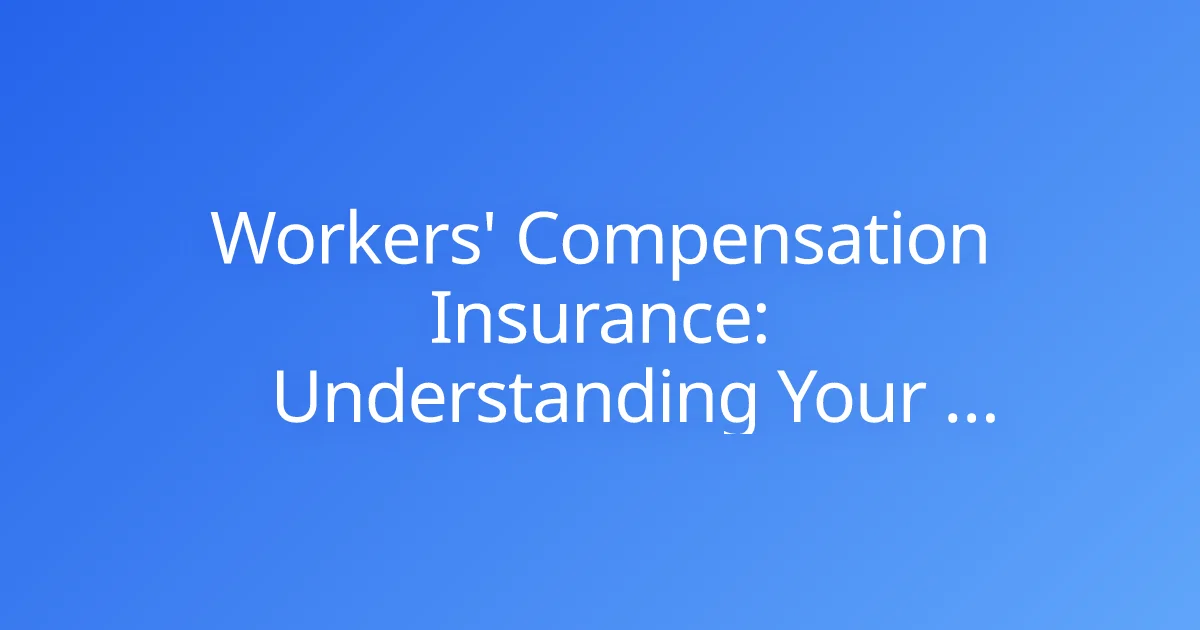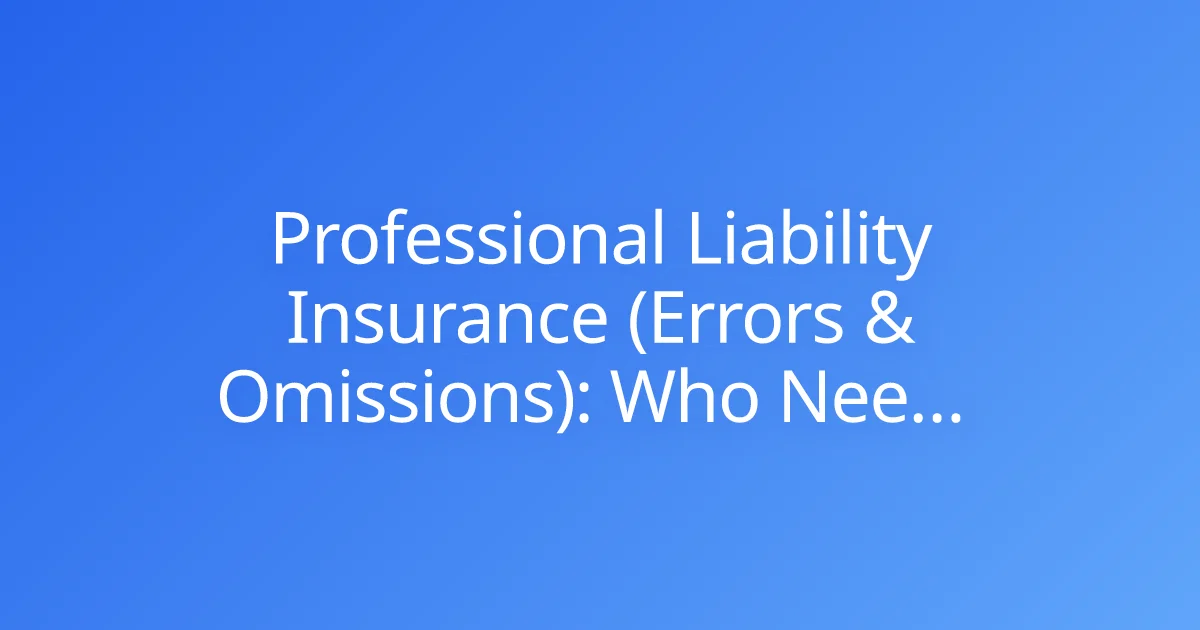Workers' Compensation Insurance: Understanding Your Obligations as an Employer
As a business owner, you juggle countless responsibilities, from securing clients and managing finances to fostering a productive work environment. Amidst these daily demands, ensuring the safety and well-being of your employees is paramount, not just ethically, but also legally. A workplace injury or illness can strike unexpectedly, bringing with it not only a human toll but also significant financial and legal challenges for your business. Many employers find themselves grappling with the complexities of Workers' Compensation Insurance, unsure of their precise obligations or the full scope of what this crucial coverage entails.
At The Policy Explainer, we simplify intricate insurance concepts for a global, non-technical audience. This comprehensive guide aims to demystify Workers' Compensation Insurance, shedding light on your obligations as an employer, detailing what it covers, and emphasizing its critical role in maintaining business compliance and protecting your most valuable asset: your workforce. By understanding this essential form of commercial insurance, you can navigate the complexities with confidence and ensure both your employees and your business are adequately protected.
What is Workers' Compensation Insurance? The Core Concept
Workers' Compensation Insurance is a form of business insurance that provides medical benefits and wage replacement to employees who are injured or become ill as a direct result of their job duties. It operates under a no-fault system, meaning benefits are typically paid regardless of who was at fault for the injury, as long as it occurred within the scope of employment.
The dual purpose of Workers' Comp is crucial to understand:
- Employee Protection: It ensures injured workers receive necessary medical care and a portion of their lost wages, preventing undue financial hardship during recovery.
- Employer Liability Limitation: In exchange for providing these guaranteed benefits, Workers' Comp generally protects employers from direct lawsuits by injured employees for negligence. This is known as the "exclusive remedy" provision.
Essentially, it's a safety net for both parties, designed to avoid lengthy and costly litigation following a workplace accident.
Your Legal Obligations as an Employer: State Requirements
One of the most important aspects of Workers' Compensation Insurance is its mandatory nature in most parts of the world. While the specifics vary, almost every U.S. state, for example, requires employers to carry Workers' Compensation coverage.
State-Specific Mandates and Variations
- Varying Requirements: The rules for Workers' Comp are set at the state level, not federal. This means your obligations as an employer can differ significantly based on where your business operates.
- Number of Employees: Some states mandate coverage for businesses with even one employee, while others have thresholds (e.g., 3, 4, or 5 employees) before coverage becomes compulsory.
- Industry-Specific Rules: Certain high-risk industries might have stricter requirements or different classifications.
- Exemptions: Some states offer exemptions for specific types of employees (e.g., agricultural workers, domestic employees), or for business owners themselves (sole proprietors, partners, or corporate officers might be able to opt out, though it's often advisable not to).
- Compliance: You must adhere to the laws of each state where you have employees, even if you are a small business operating remotely across state lines.
Penalties for Non-Compliance
Failing to secure mandatory Workers' Compensation insurance can lead to severe consequences for employers:
- Fines and Penalties: States can impose substantial daily fines for every day your business is uninsured.
- Legal Action: You could face civil lawsuits from injured employees and even criminal charges in some jurisdictions.
- Stop-Work Orders: State authorities might issue orders forcing your business to cease operations until coverage is obtained.
- Personal Liability: Without insurance, you could be personally liable for an injured employee's medical bills and lost wages, potentially leading to bankruptcy.
Understanding and fulfilling these employer obligations is not just good practice; it's a critical legal imperative.
What Does Workers' Compensation Insurance Cover? A Deep Dive
Beyond the broad definition, it's essential for employers to understand the specific benefits that Workers' Compensation Insurance provides to injured employees.
1. Medical Treatment Costs
This is the most immediate and direct benefit.
- Coverage: Pays for all reasonable and necessary medical expenses related to the work-related injury or illness. This includes emergency room visits, doctor's appointments, hospital stays, surgeries, prescription medications, physical therapy, rehabilitation, and sometimes even transportation to medical appointments.
- Purpose: Ensures the employee receives prompt and adequate care without incurring out-ofpocket costs, facilitating their recovery.
2. Lost Wages (Disability Benefits)
If an employee is unable to work due to a work-related injury or illness, Workers' Comp provides wage replacement benefits.
- Types of Disability:
- Temporary Total Disability (TTD): When an employee is completely unable to work for a temporary period.
- Temporary Partial Disability (TPD): When an employee can perform some work but not their full duties, resulting in reduced earnings for a temporary period.
- Permanent Partial Disability (PPD): When an employee sustains a permanent impairment but can still perform some work.
- Permanent Total Disability (PTD): When an employee is permanently unable to return to any gainful employment.
- Benefit Calculation: Typically, benefits are calculated as a percentage (e.g., 66.67%) of the employee's average weekly wages, subject to state-specific maximums and minimums.
3. Vocational Rehabilitation
For employees who cannot return to their previous job due to a permanent disability, Workers' Comp may cover vocational rehabilitation services.
- Coverage: This can include job training, education, job placement services, and assistance with finding new employment within their capabilities.
- Purpose: To help injured workers regain independence and re-enter the workforce in a suitable capacity.
4. Death Benefits
In the tragic event that a work-related injury or illness results in an employee's death, Workers' Comp provides benefits to their dependents.
- Coverage: Includes funeral and burial expenses, as well as ongoing financial support (wage replacement) to eligible surviving dependents (e.g., spouse, minor children).
- Purpose: To provide a measure of financial stability to the family after a devastating loss.
5. Employer's Liability Coverage
Often an often-overlooked but crucial component, this is usually part of the Workers' Compensation policy itself.
- Coverage: While Workers' Comp provides an "exclusive remedy" in most cases, there are exceptions where an employee can still sue their employer. Employer's Liability coverage protects the employer from these lawsuits, which can arise from claims such as:
- "Third-party over" lawsuits (e.g., employee sues a third party, and that third party then sues the employer).
- "Dual capacity" lawsuits (e.g., employer is also a manufacturer of a faulty product that caused injury).
- Loss of consortium claims (brought by a spouse for loss of companionship).
- Why it's Essential: This coverage bridges the gap, protecting the employer when the "exclusive remedy" rule doesn't apply, ensuring comprehensive business liability coverage.
Why Workers' Comp is More Than Just a Legal Requirement
Beyond legal compliance, carrying Workers' Compensation Insurance offers significant strategic benefits for your business.
Risk Management and Financial Protection
It's the most effective way to manage the financial risks associated with workplace injuries. Without it, a single serious incident could lead to direct costs for medical care, lost wages, and legal fees that could easily cripple a small business. Workers' Comp acts as a financial buffer, insulating your business from these potentially devastating expenses.
Boosts Employee Morale and Retention
Providing Workers' Comp demonstrates a commitment to employee safety and well-being. Knowing they are protected in the event of a workplace injury fosters trust, enhances morale, and can significantly improve employee retention. Employees are more likely to feel valued and secure, leading to greater productivity and loyalty.
Protects Your Business Reputation
Being uninsured and unable to adequately care for an injured employee can severely damage your business's reputation within the community and among potential employees. Conversely, having proper coverage signals responsibility and professionalism, enhancing your brand image.
Streamlined Claims Process
Workers' Compensation systems are designed to manage injury claims efficiently. Your insurer handles the complex processes of investigating the claim, coordinating medical care, calculating benefits, and managing litigation, allowing you to focus on running your business.
Key Steps for Employers: Fulfilling Your Workers' Comp Obligations
Navigating your Workers' Compensation obligations requires a proactive approach.
1. Understand Your State's Laws
Begin by thoroughly researching the specific Workers' Compensation laws in your state(s) of operation. This includes:
- The minimum number of employees that triggers the requirement.
- Specific industry exemptions or inclusions.
- Rules regarding sole proprietors, partners, and corporate officers.
- Penalties for non-compliance. Your state's Department of Labor or Workers' Compensation Board website is typically the best resource.
2. Obtain Proper Coverage
Once you understand your obligations, secure a policy from a licensed insurer.
- Private Insurers: Most businesses purchase coverage through private insurance companies.
- State Funds: Some states operate a monopolistic or competitive state fund where employers must (or can choose to) purchase coverage directly from the state.
- Self-Insurance: Larger, financially stable businesses may be permitted to self-insure, meaning they directly pay for claims, but this requires substantial financial reserves and state approval.
3. Establish and Maintain Workplace Safety Programs
Proactive safety measures can significantly reduce the risk of workplace injuries, which in turn can lead to lower Workers' Comp premiums.
- Safety Training: Implement regular safety training for all employees.
- Hazard Identification: Regularly inspect your workplace for potential hazards and address them promptly.
- Safety Protocols: Develop and enforce clear safety protocols and procedures.
4. Report Injuries Promptly and Accurately
If an employee sustains a work-related injury or illness, prompt reporting is critical.
- Timeliness: Most states have strict deadlines for reporting injuries to both the state Workers' Comp board and your insurance carrier.
- Accuracy: Provide all necessary details about the incident, employee, and medical treatment.
5. Cooperate with Your Insurer and Medical Providers
Work closely with your Workers' Comp insurer and the medical professionals involved in the employee's care.
- Information Sharing: Provide any requested documentation and information to facilitate the claims process.
- Return-to-Work Programs: Where appropriate, work with your insurer and medical provider to implement a gradual return-to-work program for recovering employees.
6. Educate Your Employees
Ensure your employees understand their rights and responsibilities regarding Workers' Comp.
- Post Notices: Display required Workers' Comp notices in a visible location.
- Explain Procedures: Clearly communicate how and when to report injuries and what benefits they may be entitled to.
Factors Influencing Your Workers' Comp Premiums
Just like other forms of business insurance, the cost of Workers' Compensation Insurance is not fixed. Several factors influence your premiums:
- Payroll: Premiums are typically calculated based on a percentage of your total employee payroll. Higher payroll usually means higher premiums.
- Employee Classification Codes: Each job function within your business is assigned a classification code (e.g., clerical, construction, retail). These codes reflect the inherent risk associated with that type of work, with higher-risk classifications incurring higher rates.
- Experience Modifier (Mod Rate): This is a crucial factor for businesses with a claims history. Your "experience modifier" adjusts your premium up or down based on your past claims compared to other similar businesses in your industry. A good safety record (fewer claims) can result in a lower mod rate and significant premium savings. A poor record leads to a higher mod rate and increased costs.
- State Regulations: As discussed, state laws dictate rates, benefit levels, and specific requirements, which directly impact premium costs.
- Industry Risk: Businesses in inherently dangerous industries (e.g., construction, manufacturing) will generally pay higher base rates than those in low-risk industries (e.g., office-based businesses).
- Deductibles and Policy Limits: Opting for a higher deductible (the amount you pay before coverage kicks in) can lower your premium, but ensure you can afford it.
Conclusion
For every employer, understanding Workers' Compensation Insurance is not just about fulfilling a legal requirement; it's about making a strategic investment in the well-being of your workforce and the financial stability of your business. By grasping your obligations as an employer, comprehending what Workers' Compensation covers, and implementing proactive safety measures, you can create a safer workplace, ensure injured employees receive proper care, and shield your business from potentially devastating financial and legal repercussions. This essential coverage provides a robust safety net, allowing you to focus on your business's growth with confidence and peace of mind. Do you have more questions about your state's specific Workers' Comp requirements or how to manage your premiums effectively?



